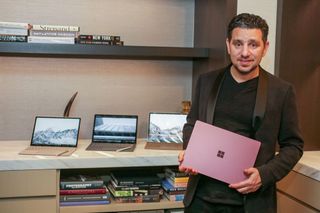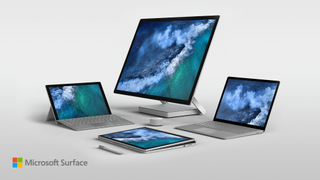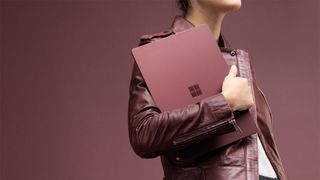Microsoft must passionately market Surface Laptop to take on Apple's MacBook
Microsoft wants MacBook-loving college students to switch to its new Surface Laptop. But is the company's marketing team ready to take on Apple?

On May 2, 2017, Microsoft introduced a new addition to its family of first-party hardware, the Surface Laptop. Unlike the Surface Pro, Book and Studio, the Surface Laptop does not create a new category, however.

How Surface changed Microsoft forever
It doesn't have a removable display like the Pro or Book, nor can the screen be positioned at a 20-degree angle for a drafting-table effect like the Studio. It's just a laptop. A premium laptop, yes, but a laptop nonetheless. Microsoft's Devices Chief Panos Panay asserted during its introduction, however, that this laptop redefines the category.
He claimed his team built the optimal combination of design, feature set, battery life and more, making the Surface Laptop the most balanced laptop on the market. It is this premium laptop that Microsoft is pitting against the preferred laptops among college students, Apple's MacBook Pro and MacBook Air.
Surface Laptop vs. MacBook: It isn't all about specs
Microsoft's challenge will be communicating the passion that went into creating the Surface Laptop. Panay's team of engineers who poured their passion into crafting every detail of the Surface Laptop is not the team that will market it to consumers, however. Microsoft's marketing team has the daunting responsibility of persuading Apple-loving college students to buy a laptop from a company their uncool parents, perhaps, grew up loving.

Undoing and replacing the student-MacBook relationship, with a student-Surface Laptop relationship, will require a long campaign and tremendous resources.
It will (or should), therefore, span many quarters and must integrate the passion, not just the specs, the Surface team put into the product.
Get the Windows Central Newsletter
All the latest news, reviews, and guides for Windows and Xbox diehards.
Panay's passion
No one knows a product better than its creator. When that creator can also verbally express the merits and features of that product with the same passion that went into making it, an audience feels it. During his introduction of the Surface Laptop, Panay did just that and explained how his passion began with lessons he learned from his father, as seen starting at the 1:02:10 in the video below:
My dad and I shared a room. His desk was in my room. He'd come in every night, and he'd go to work. I'd creep out of bed and go sit with him. He used to teach me. We would build TVs together ... He'd talk about every single detail and how it mattered. And if you got it wrong, then you'd have to do it again. And you'd have to do it again. And then again. But it mattered that you didn't miss anything. Because if you put everything that you had into this product, then you'd get everything you wanted out of it.
We see the fruit of these lessons in Panay's persistence and attention to detail that brought Surface from a billion dollar loss to an industry-inspiring, category-creating, billion dollar business.
Panay added that his team puts its heart and soul into every single detail, from the tiniest hinge to the creation of a product category to every small bit being aligned with a pixel on the screen.
He also said, "It's not all the details and parts that make these devices great, but it's all the passion that the people making these products put into them. It's that same passion that we want you to feel when you're using our products."
Is Microsoft's marketing team 'feeling' Panos?
Will Microsoft's marketing team put "Panay-level" passion into persuading students to use the Surface Laptop over a MacBook? It'll have to if consumers are to "feel" the passion that went into making the product.

Sadly, Microsoft's commitment to products and its marketing efforts have been inconsistent at best. Xbox and Bing received continued support even in extremely competitive spaces. Conversely, the Kin which was dropped after 48 days, Zune which was dumped after five years, and Windows phones, which lacked the comprehensive support of consistent, aggressive marketing and efforts to ensure broad distribution, have all been allowed to flounder.
Thankfully, Microsoft's Surface devices have risen to represent the company in the way Windows as an OS and Office for productivity have for years. Consequently, Surface receives more consistent marketing support from Microsoft than some less esteemed products. The Surface Laptop, therefore, should get the necessary support from Microsoft.
Microsoft must convey emotion in Surface Laptop marketing
Convincing 17-year-old to 20-year-old college students to give up "cool" MacBooks for laptops from a company whose efforts have focused primarily on the enterprise is a lofty goal for Microsoft.

As with many successful products, there's both an emotional and social aspect that contributes to MacBook's success, beyond its specs and capabilities. For college students, MacBooks are the socially endorsed laptop. As an Apple product, it benefits from the intangible value that makes virtually anything Apple brings to market a media sensation and the bar to which the rest of the industry is compared. Like it or not this is the reality Microsoft is up against.
Marketing that doesn't connect emotionally with the intended audience and that focuses only on the very balanced and competitive specs of the Surface Laptop will likely fail. Panay's passion-laden presentation of the Surface Laptop is the combination of emotion and information I believe Microsoft's marketing message will need.
This war won't be won in a day
As with any "war," Microsoft won't win college students with just one commercial during one fiscal quarter. It must be committed to what may amount to years of "battles" as it attempts to wrest from Apple what Apple is determined to retain.
For instance, Apple introduced updated specs for the MacBook and MacBook Air at WWDC 2017. Those updated specs already alter Microsoft's recent claim that Surface Laptop is 50 percent faster than MacBook and MacBook Air.
Given the swiftly evolving tech industry, a spec race cannot be Microsoft's marketing focus. The Surface Laptop is a challenger to Apple's beloved incumbent. Understanding that it's just the first of many iterations, Microsoft's marketing must have the stamina to strive over time to build an emotional connection with students by conveying the passion that went into the product.
The challenge of Windows 10 S
Added to introducing a new product, communicating its specs, and passionately building an emotional connection with students, Microsoft has the challenge of explaining Windows 10 S.
The Surface Laptop runs the newest version of Windows which is more secure but runs only Windows Store apps. Classic Win32 programs like Chrome won't run on this device without a $50 (temporarily free) upgrade to Windows 10 Pro.
Microsoft must manage consumer expectation of Windows 10 S
The potential for angering unaware consumers who take a chance on the Surface Laptop is real. Microsoft must be proactive and comprehensive in its messaging to avoid alienating members of the very market it's trying to win.
Is Microsoft up to the challenge?
Will the marketing message do the product and the Surface team's efforts justice?
Some enthusiasts argue that Panay should market products. That's a longshot, but perhaps snippets of his presentation could be incorporated in some of the Surface Laptop television ads. "Normal consumers" would then feel what we techies feel when we hear the Surface's creator talk about the product. That's one way to ensure the passion that has gone into the product is integrated into the marketing.
Whatever Microsoft does, it must be persistent, creative, passionate and above all, ready. Apple's marketing prowess is unmatched. Rest assured that the marketing juggernaut won't sit idly by as Microsoft makes a play for MacBook-using college students.
The war is on.
Also Read:
With Windows 10 S and Surface Laptop, Microsoft takes aim at Apple and Google
Jason L Ward is a columnist at Windows Central. He provides unique big picture analysis of the complex world of Microsoft. Jason takes the small clues and gives you an insightful big picture perspective through storytelling that you won't find *anywhere* else. Seriously, this dude thinks outside the box. Follow him on Twitter at @JLTechWord. He's doing the "write" thing!

